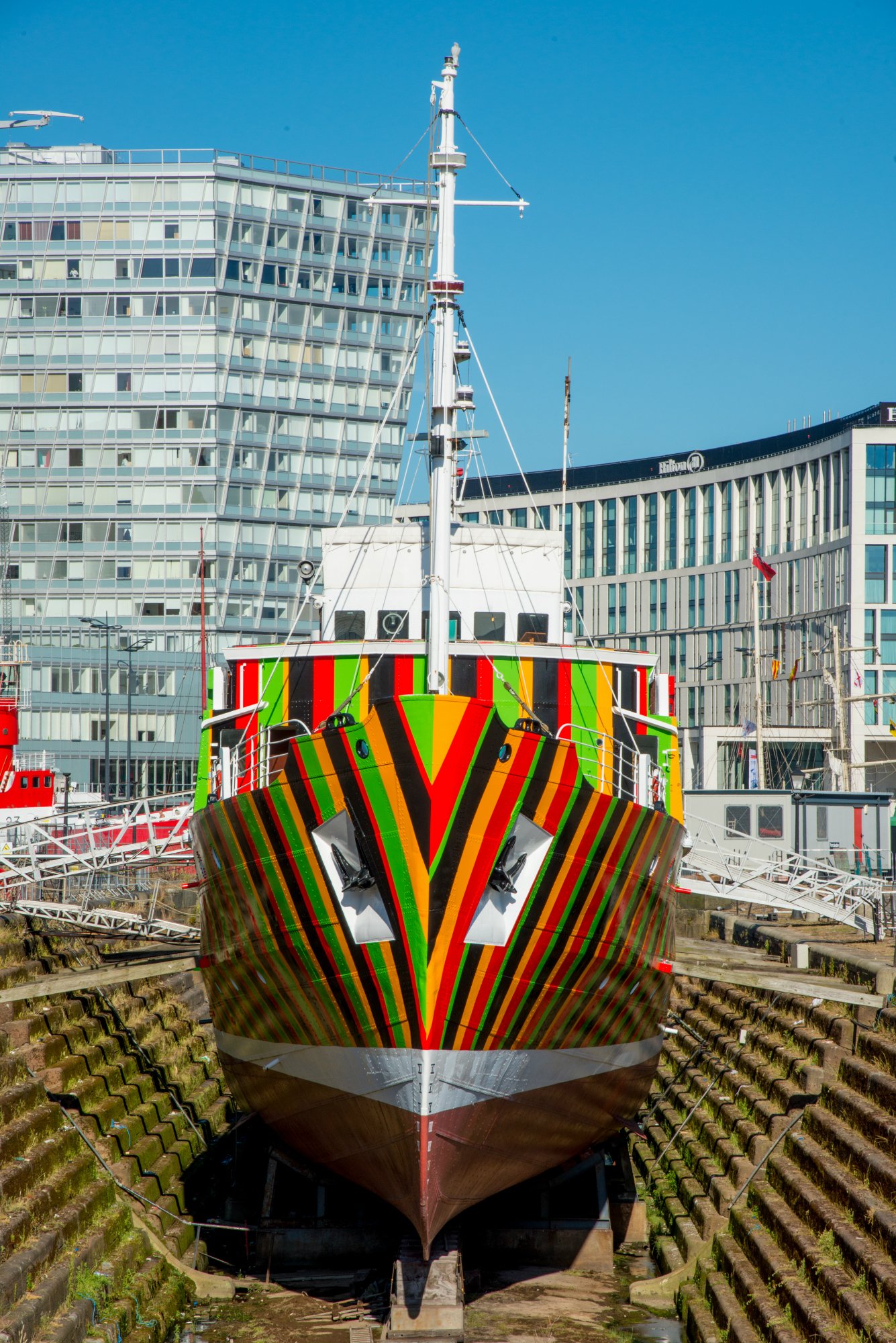
In 1918, the New York Harbor put on art show of sorts. Hundreds of US warships waiting to carry men and supplies to Europe during World War I were painted not in battleship gray but in bright, contrasting colors and geometric patterns. The novel designs, called “dazzle camouflage,” were intended to distract the U-boat crews lying in wait to sink them. One American journalist called the ships “floating Cubist paintings.” Dazzle designs soon became all the rage. It was a far cry from the hostile reception given to modern art from Europe at the Armory Show in 1913.
Now, a century later, artist Tauba Auerbach is following in the footsteps of the artists who devised the designs that helped the Allies win World War I. She is painting her own dazzle ship, and it will set sail this July.
Detail of the concept sketch for Flow Separation (March 2018) courtesy of Tauba Auerbach.
“I’m interested in the unlikely intelligence of dazzle camo. I like that it works to outsmart rather than hide,” Auerbach tells artnet News. “It’s like prioritizing ‘ingenuity over virtuosity,’ which is something I say to myself all the time in my head.” The 1918 designs were created to be seen from the periscope and confuse gunners about the range, direction, and speed of his moving target. More than 4,000 British and US boats were painted with the wild patterns.
Auerbach says that she is particularly interested in the range-finding instruments of the time, which would slice an image horizontally so the viewer would have to adjust it until the two halves coincided. “Dazzle ships often had slices cutting through their designs, so when a person tried to align their bisected view, they’d get muddled between the schism in the lens and the ones in the paint,” she points out. Her design is called “Flow Separation.”
Fireboat John J. Harvey, courtesy David Grill
The artist has been co-commissioned to transform a fireboat by New York’s Public Art Fund and 14-18 Now. It is part of a four-year project to commemorate World War I through contemporary art and performance. Bloomberg Philanthropies is also supporting the project.
Auerbach’s dazzle ship is the fifth and final vessel and the only one to set sail in the US. The first was painted by Carlos Cruz-Diez in Liverpool, followed by Tobias Rehberger’s in London, Peter Blake’s also in Liverpool, and Ciara Phillips’s in Edinburgh.
When Auerbach’s dazzle camo design is unveiled in the summer, the vessel, called John J. Harvey, will dock at various locations around the New York Harbor and make free trips along the city’s waterways. Auerbach, who was born in San Francisco, says the project has given her a new view on New York’s history as a port city. “[It’s] been a pleasure to see New York from another perspective, through the eyes of people caring for boats and the waterfront,” she says. “New York is what it is because of its relationship to the water.”
The man credited with convincing the British Admiralty to replace gray paint for the dazzling designs was a traditional maritime artist who was serving in the Royal Navy. Norman Wilkinson and his team worked in studios at London’s Royal Academy of Arts to create bespoke designs for the thousands of vessels. The young Franklin Delano Roosevelt, who was assistant to the secretary of the US Navy, was impressed. Soon hundreds of US ships were being jazzed up, too.
See more dazzle ships from the 14-18 Now fleet and USS West Mahoment in 1918.
Ciara Phillips, Dazzle Ship (2016–18), photograph copyright Ross Attenburgh.
Peter Blake, Everybody Razzle Dazzle. Photograph by Mark McNulty.
Tobias Rehberger, Dazzle Ship London, (2014).
USS Mahomet, 1918. Wikipedia, photograph from the Bureau of Ships Collection in the U.S. National Archives.